Vascular Conditions
The following are descriptions of the various vascular conditions that we treat at Sun Vein & Vascular. As always, please feel free to reach out to our team if you have any questions regarding vascular conditions or treatments or if you would like to schedule an appointment. We look forward to serving you!
Varicose Veins
What are Varicose Veins?
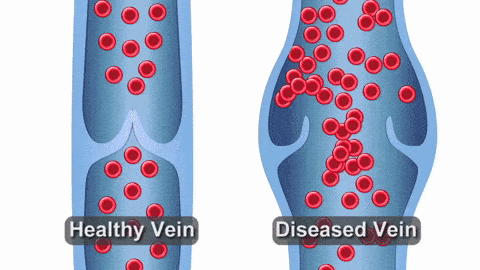
Varicose veins are large, twisting blue vessels that appear in the skin anywhere from the thigh to the foot. They are caused by inefficient, faulty vein valves; when they don't close properly, blood leaks back with gravity and pools in the vein. Leg pain associated with varicose veins is usually due to swelling of the veins and the surrounding tissues. A painful and red lump where varicose veins are located is nearly always a sign of phlebitis.
Heredity is a primary factor in over 80% of varicose vein cases. Other contributing factors may include:
- Pregnancy
- Obesity
- Hormone therapy
- Standing or sitting for long periods
- Injury
What are the Side Effects of Varicose Veins?
Varicose veins are not just a cosmetic disorder; the veins bulge and stretch, resulting in many unpleasant side effects, such as:
- Heavy and tired legs
- Aching and throbbing pain
- Swelling
- Leg cramps
- Restless leg syndrome
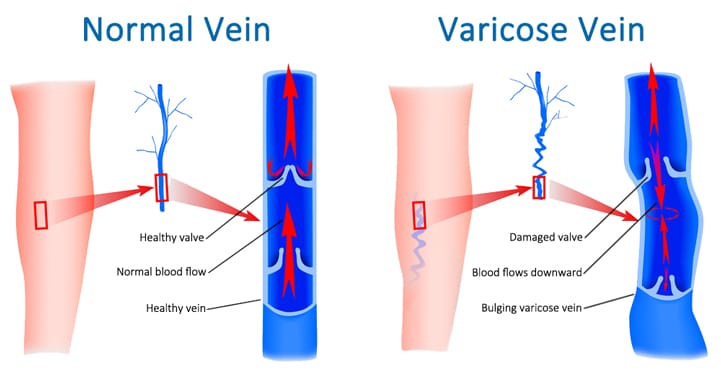
How are Varicose Veins Diagnosed?
At Sun Vein & Vascular, we treat vein issues using a stepwise approach. We start by identifying the problem with an ultrasound study of the legs. Once the bad veins are identified, we discuss the various treatment options and tell you which ones we think are best for you.
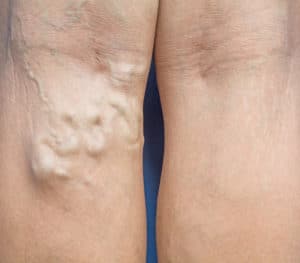 Learn About Our Treatment Options
Learn About Our Treatment Options
Spider Veins
Spider veins are broken capillaries, formally named telangiectasias, which are red, blue, or purple thread-like veins (less than 2mm in diameter, flat or raised) on the surface of the skin. Though smaller than most varicose veins, spider veins are often darker and more noticeable. This is because these veins are located just below the skin's surface.
Spider and reticular veins may be triggered by pregnancy or hormonal variations and are, therefore, more common in women. They may result in itching, leg restlessness, aching, and throbbing. Bleeding may also occur from traumatized spider veins from shaving or household chores. Non-symptomatic spider veins may also be found on the face, chest, and legs. Although some consider surface veins to be a cosmetic problem, they can also be just as symptomatic as classic varicose veins.
Learn About Our Treatment Options
Restless Legs
Restless Leg Syndrome (RLS) affects as much as 15 percent of the general population. The symptoms include irresistible urges to move your legs, a "creeping feeling, persistent leg movement during sleep, or tingling, burning, aching, or numbness of the legs." These symptoms are worse at night or during periods of relaxation, such as lying down during the day.
RLS & Varicose Veins
Venous insufficiency is an often-overlooked cause of RLS. Several studies indicate that as many as 22% of those with RLS also have venous insufficiency. When this happens, RLS can be improved significantly by treating the varicose veins. A simple office evaluation and noninvasive duplex ultrasound of your legs is the first step you should take.
Learn About Our Treatment Options
Skin Problems
Dermatitis
Stasis dermatitis, or stasis eczema, is a common inflammatory skin problem of the legs that occurs in patients with chronic venous insufficiency, varicose veins, edema, lipodermatosclerosis, and ulcerations. Contact our office today to get started on a treatment plan for dermatitis issues.
Venous Ulcers
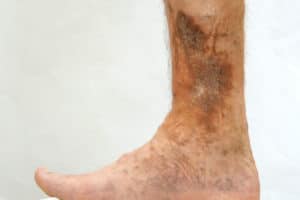
A venous ulcer is a shallow skin wound that develops when the veins don't return blood to the heart as they normally would, known as venous insufficiency. These ulcers usually develop on the sides of the lower leg, above the ankle, and below the calf. Also called stasis leg ulcers, these heal slowly and often come back without preventative treatment.
We can diagnose skin ulcers by asking questions about your health, examining affected areas, and performing ultrasound testing. We may use other tests to check for problems related to venous skin ulcers to recheck the ulcer if it does not heal within a few weeks after starting treatment.
Learn About Our Treatment Options
Blood Clots
Thrombophlebitis
Thrombophlebitis is inflammation of a vein caused by a blood clot (also known as a thrombus) that blocks one or more veins in your legs. There are a variety of symptoms that may accompany thrombophlebitis, including:
- Swelling
- Pain
- Warmth
- Redness
When a vein close to the surface of your skin is affected, you might see a red, hard cord just under the surface of your skin that's tender to the touch. When a deep vein in the leg is affected, it may become swollen, tender, painful and is usually difficult to walk on.
We understand the serious impact that thromboembolic disease has on our patients and their families. As the underlying venous disease can play a significant role in most patients affected by thrombophlebitis, we will collaborate with your referring physician to determine the best care plan for you.
Deep Venous Thrombosis (DVT)
Deep vein thrombosis usually occurs in the lower extremities and is a clot that forms in the deep vein system. The venous system of the lower extremity is divided into the superficial veins, which include the great and small saphenous veins and their associated accessory tributaries, and the deep venous system, which includes the femoral and popliteal veins. Intermediate veins called perforators connect them. DVT can lead to partial or complete blockage of circulation, which can cause serious medical problems. Nearly 2 million Americans are affected by DVT each year.
Vacations are a particularly dangerous time for DVT. Travel on an airplane, car, bus, or train increases your risk, especially if you have recently had surgery, are pregnant, are overweight, or have a history of blood clots. Risk of DVT should not keep you from traveling if you take these simple steps:

- Wearing compression stockings while traveling can significantly reduce your risk for DVT. These stockings help increase the circulation in your legs. Make sure to purchase medical-grade stockings.
- Stay hydrated. Drink lots of water and avoid caffeine or alcohol because both are dehydrating.
- Wear loose, comfortable clothes during the trip.
- Get up out of your seat every hour or two. In an airplane, it is helpful to request an aisle seat, so it is easier to stretch out and move around. In a car, stop at a gas station or rest area and walk around every couple of hours.
- While seated, rotate your ankles, draw circles on the ground with your toes, flex your feet and toes and raise your legs slightly, holding them in the air for a few seconds.
Swelling
Edema
Edema is swelling produced by the expansion of the fluid in the tissue; when massive and generalized, the excess fluid accumulation is called anasarca. A variety of conditions are associated with the development of edema, including heart failure, liver disease, and kidney disease, as well as local conditions such as venous and lymphatic disease.
Lymphedema
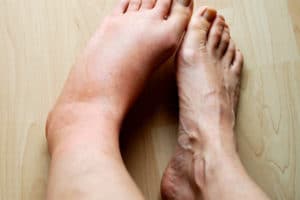
Lymphedema is swelling that occurs in the arms or legs. While there is presently no cure for lymphedema, it can be managed with early diagnosis and diligent care of your affected limb. Make an appointment with your doctor if you notice persistent swelling in your arm or leg. If you already have the diagnosis of lymphedema of a limb, see your doctor if there is a sudden dramatic increase in the size of the involved limb, as it may suggest a new process is occurring.
Lower extremity lymphedema may be related to prior surgery, radiation treatment, trauma, or infection. It is also common to see lower extremity lymphedema be related to chronic venous insufficiency/varicose vein disease, known as phlebolymphedema. The interaction between the lymphatic system and problematic lower extremity superficial venous issues is gaining wider recognition worldwide.
For some patients with phlebolymphedema, addressing underlying venous issues may help control lower extremity swelling. The lymphatic system, which is also part of your immune system, relies on a small caliber network of vessels to convey fluid out of the space between the body's cells, known as the interstitium. Damage or blockage of these vessels prevents lymph fluid from draining well, and the fluid buildup leads to swelling.
Learn About Our Treatment Options
Peripheral Arterial Disease
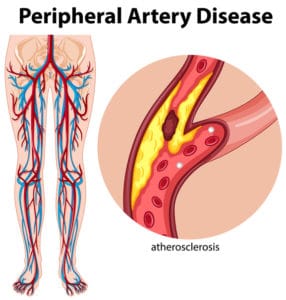
Peripheral arterial disease (PAD) is the narrowing or blockage of the arteries leading to decreased blood flow to your arms and legs. When a person develops peripheral arterial disease, their limbs don't receive enough blood flow to keep up with demand. PAD usually occurs in the legs, and it can cause symptoms such as leg pain when walking.
Dr. Sun and our team diagnose and treat peripheral arterial disease for our patients across the Dallas, TX, area.
Some symptoms associated with peripheral arterial disease:
- Painful cramping in one or both of your hips, thighs, or calf muscles after certain activities, such as climbing stairs
- Leg numbness
- Leg weakness
- Sores on your toes, feet, or legs that won't heal
- Coldness in your lower leg or foot, especially when contrasted with the other leg
- Color change in your legs
- Shiny skin on your legs
- No pulse or a faint pulse in your legs or feet
- Pain when using your arms, such as aching when writing or doing other movements with your hands
Pelvic Congestion Syndrome (PCS)
At Sun Vein & Vascular, we offer effective, personalized care for women with pelvic congestion syndrome. Symptoms often don't appear until a woman becomes pregnant, and then they continue after pregnancy. The main symptom of PCS is pelvic pain. Pelvic congestion syndrome occurs when varicose veins develop around the ovaries, similar to varicose veins that occur in the legs.
Risk Factors
Most women with pelvic congestion syndrome are younger than 45 and in their childbearing years. Certain factors can put a woman at higher risk for the condition, including:
- Multiple (two or more) pregnancies
- Presence of a "tipped" (retroverted) uterus
- Fullness of the leg veins
- Polycystic ovaries
- Hormonal increases or dysfunction
May-Thurner Syndrome (MTS)
May-Thurner syndrome (MTS) is caused when the left iliac vein is compressed by the right iliac artery. Most people do not know they have MTS, but it is identified when they present with deep vein thrombosis (DVT). Patients should seek treatment for symptoms, including:
- Swelling, pain, or tenderness in the leg
- Feeling of increased warmth in the leg
- Redness or discoloration of the skin
- Enlargement of the veins in the leg
Even though DVT itself is not life-threatening, the blood clot has the potential to break free and travel through the bloodstream, where it can become lodged in the blood vessels of the lung (known as a pulmonary embolism). This can be a life-threatening condition.
Learn About Our Treatment Options
Paget Schroetter Syndrome
Paget–Schroetter disease, also known as Paget–von Schrötter disease, is a form of upper extremity deep vein thrombosis (DVT), a medical condition in which blood clots form in the deep veins of the arms. These DVTs typically occur in the upper arm, chest, and neck veins. The condition is relatively rare. It usually presents in young and otherwise healthy patients and also occurs more often in males than females. Symptoms to look for include:
- Pain in the arm
- Feeling of increased warmth
- Increased redness or blueness
- Swelling
Learn About Our Treatment Options






.jpeg)
.jpeg)



